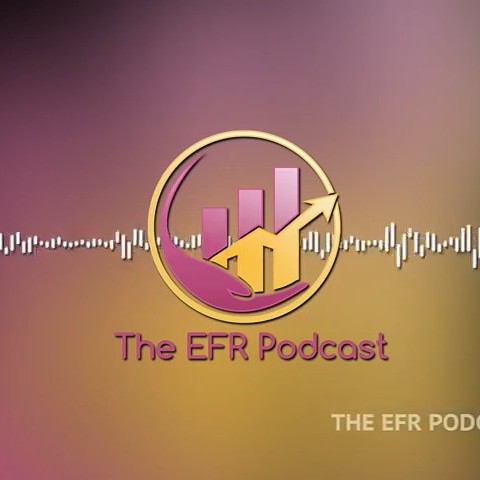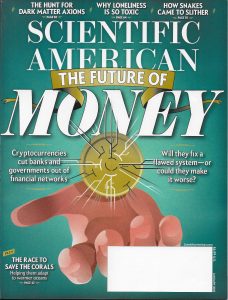Economic & Finance Report
By: James Lyman BSAE, BSEE, MSSM
I just got my January issue of Scientific American with a collection of articles about the future of money detailing how new technologies promises to profoundly change the monetary and banking systems and hence the economic system which millennials are already struggling for a place in. This special report of four articles is very interesting giving a glimpse of how the world of the millennials and Z-generation is changing such as stopping the concentration of wealth, increased transparency while reducing risks, but increasing risks to our digital identities. This issue is a good introduction to the ‘what and particulars’ of the new technologies of money, but leaves the reader with the question: How will the millennials fair in a new economy when they’re now struggling so much in the old one?
First, just what is cryptocurrencies such as Bitcoin and Tradecoin? Well, as the articles explains, cryptocurrencies are just as the name implies, money or currency that is data bits in computer systems instead of the traditional metal coins and paper bills we’ve come to think of money as. This allows individuals and companies to buy and sell physical assets across the internet using cryptocurrencies instead of traditional money. These cryptocurrencies are not like credit cards used to transfer money, which are in fact just another manifestation of tradition money issued by nations that we use every day. Instead they are a money or currency created by individual private companies. These use the technology of blockchaining to give a peer-to-peer digital payment system without any central authority.
Immediately there is the obvious problem of what gives this kind of money any value? The money of a nation represents the cumulative value of a nation. The sum value of a nation’s factories, farms, mineral resources and infrastructure, coupled with the value of all the personal property such as houses and cars is what gives money its value. The sum total of all the assets of a nation! So the money from a rich nation is more valued, considered more stable, than one from a poor nation. During World War II and several decades after, the American dollar was more valued than gold. It was more sought after, more readily accepted than pure gold, because of the vast wealth that stood behind the dollar. People across the world wanted American dollars above all else.
But cryptocurrencies is the creation of money out of thin air . . . there is no physical assets to back Bitcoin and Tradecoin. (Tradecoin does used commodities to back their currency, but commodities are perishable, and so its value can be questionable.) One only has to look briefly at history, at the Weimar Republic after World War I, when the defeated Germans decided to pay reparations to the Allies by simply printing more money. Quickly inflation became ramped with a wheelbarrow of paper money needed to buy a loaf of bread. The paper used to print the money on, cost more than what the money was worth. And this opened the door for the National Socialist and Hitler to step in and gain total power. Cryptocurrencies lack hard tangible wealth for their money to represent.
Creating money is a finicky endeavor. Prior to the great depression of the thirties, the American dollar was on the gold standard, that is a dollar bill could be redeemed from the American government for a set amount of gold. It had value because it was backed by gold which most people consider to have value. The paper dollar bill was a light weight convenient way to carry gold around and exchange for goods and services. But there was a fixed amount of gold that America had, which in turn fixed how much money the government could issue. That put a limit on how big America’s economy could be, so to have room to grow further and get America out of the depression, President Roosevelt took America off the gold standard. Some people say we should return to the gold standard to return stability to the dollar and America’s economy, but there simply isn’t near enough gold for all the money now needed for our economy to operate.
Therefore, if you create too much money, then you risk inflation with its value falling away, while if you create too little, then you risk strangling the economy which can be just as bad.
That’s the real risk with cryptocurrencies, the creation of money out of thin air, without any consideration over the consequences of too much or too little money, coupled with no anchor to real material wealth. This translates into Trust, one of the most important factors of any currency. To use a currency, to accept it in exchange for some material item of value, both parties must have trust that the currency will be accepted and trust that the currency has value to warrant trading something of value for.
As with any new technology, many have plans to revolutionize banks, economies and money. Some think they can use cryptocurrencies to cut the banks and governments out of the financial world and thus make the world a better place, others that they can fix a flawed system. For instances, Venezuela is trying to cure its hyper inflation by creating a cryptocurrency. One thing is for sure, the future economies, which millennials will have to live in and with . . . are now being formed and remade. But what’s in it for them? Will the new cryptocurrencies mean more opportunities for them with a brighter future, or will there be more technology displacements of millennials?
These are a set of financial articles each millennial needs to read and ponder, since they are the ones who’s world will be changed one way or the other.

